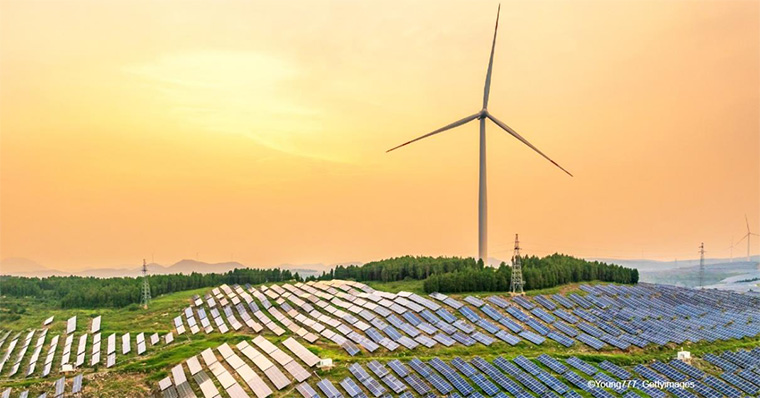A review by the SUN DAY Campaign of data released by the Federal Energy Regulatory Commission (FERC) reveals that the combination of solar and wind accounted for almost 98% of new U.S. electrical generating capacity added in the first two months of 2025. Solar alone accounted for nearly three-quarters of the new capacity in January + February. Moreover, February was the eighteenth month in a row in which solar was the largest source of new capacity.
In its latest monthly “Energy Infrastructure Update” report (with data through February 28, 2025), FERC says 39 “units” of solar totaling 1,514 megawatts (MW) were placed into service in February along with two units of wind (266-MW). Combined they accounted for 95.3% of all new generating capacity added during the month. The balance was provided by natural gas (87-MW).
For the first two months of the year, renewables (6,309-MW) were 97.6% of new capacity while natural gas (147-MW) provided just 2.3% with another 0.2% coming from oil (11-MW).
Solar accounted for 81.1% of all new generating capacity placed into service in February. It was 73.3% of new capacity added during the first two months of 2025.
Contributing to solar’s recent additions were the 237.3-MW Fence Post Solar Project in Texas as well as the 150.0-MW Northern Orchard Solar Project in California, the 135.0-MW Prairie Ronde Solar Project in Louisiana, and the 120.0-MW Ross County Solar Project in Ohio.
Solar has now been the largest source of new generating capacity added each month for eighteen consecutive months: September 2023 – February 2025.
Solar plus wind accounts for almost a quarter of U.S. generating capacity
New wind accounted for most of the balance (14.3%) of capacity additions in February. New wind capacity (1,568-MW) added in January + February combined was 70% more than that added during the same period a year earlier (922-MW).
February’s new wind capacity consisted of the 140.3-MW Pioneer DJ Wind Project in Texas and the 126.0-MW Downeast Wind Project in Maine.
The installed capacities of solar (10.7%) and wind (11.8%) are now each more than a tenth of the nation’s total. Taken together, they constitute almost one-fourth (22.5%) of the U.S.’s total available installed utility-scale generating capacity.
Moreover, approximately 30% of U.S. solar capacity is in the form of small-scale (e.g., rooftop) systems that is not reflected in FERC’s data. [1] Including that additional solar capacity would bring the share provided by solar + wind to more than a quarter of the nation’s total.
With the inclusion of hydropower (7.6%), biomass (1.1%) and geothermal (0.3%), renewables currently claim a 31.5% share of total U.S. utility-scale generating capacity. If small-scale solar capacity is included, renewables are now about one-third of total U.S. generating capacity.
For perspective, a year earlier the mix of utility-scale renewables accounted for 29.3% of total installed generating capacity. Five years ago, it was 22.6%. Ten years ago, it was 16.9% (with more than half provided by hydropower). Thus, over the past decade, renewables’ share of U.S. generating capacity has nearly doubled. [2]
Will solar soon be the second-largest source of U.S. generating capacity?
FERC reports that net “high probability” additions of solar between March 2025 and February 2028 total 89,497-MW – an amount almost four times the forecast net “high probability” additions for wind (22,890-MW), the second fastest growing resource. FERC also foresees net growth for hydropower (1,323-MW) and geothermal (92-MW) but a decrease of 130-MW in biomass capacity.
Taken together, the net new “high probability” capacity additions by all renewable energy sources would total 113,672-MW.
On the other hand, there is no new nuclear capacity in FERC’s three-year forecast while coal and oil are projected to contract by 24,939-MW and 2,104-MW respectively. Natural gas capacity would expand by 1,583-MW.
Thus, adjusting for the different capacity factors of gas (59.7%), wind (34.3%), and utility-scale solar (23.4%), electricity generated by the projected new solar capacity to be added in the coming three years should be at least 20 times greater than that produced by the new natural gas capacity while wind’s new electrical output would eclipse gas by eight-fold. [3]
If FERC’s current “high probability” additions materialize, by March 1, 2028, solar will account for nearly one-sixth (16.3%) of the nation’s installed utility-scale generating capacity. Wind would provide an additional one-eighth (12.7%) of the total. Thus, each would be greater than coal (12.4%) and substantially more than either nuclear power or hydropower (7.3% and 7.2% respectively).
In fact, assuming current growth rates continue, the installed capacity of utility-scale solar is likely to surpass coal and wind within the next two years, placing solar in second place for installed generating capacity – behind only natural gas.
Combined capacities of all renewables to exceed natural gas within 3 years
The mix of all utility-scale (i.e., >1-MW) renewables is now adding about two percentage points each year to its share of generating capacity. At that pace, by March 1, 2028, renewables would account for 37.6% of total available installed utility-scale generating capacity – rapidly approaching that of natural gas (40.2%) – with solar and wind constituting more than three-quarters of the installed renewable energy capacity. If those trendlines continue, utility-scale renewable energy capacity should surpass that of natural gas in 2029 or sooner.
However, as noted, FERC’s data do not account for the capacity of small-scale solar systems. If that is factored in, within three years, total U.S. solar capacity (i.e., small-scale plus utility-scale) could approach 330-GW. In turn, the mix of all renewables would then exceed 40% of total installed capacity while natural gas’ share would drop to about 37%.
Moreover, FERC reports that there may actually be as much as 220,985-MW of net new solar additions in the current three-year pipeline in addition to 67,811-MW of new wind, 9,788-MW of new hydropower, 201-MW of new geothermal, and 39-MW of new biomass. By contrast, net new natural gas capacity potentially in the three-year pipeline totals just 20,856-MW. Consequently, renewables’ share could be even greater by late winter 2028.
“The Trump Administration’s assault on wind and solar have not – at least not yet – had an appreciable impact on the rapid growth of renewable energy generating capacity,” noted the SUN DAY Campaign’s executive director Ken Bossong. “Moreover, if FERC’s current projections materialize, the mix of renewables will surpass natural gas capacity before the end of President Trump’s time in the White House.”
Federal Energy Regulatory Commission | https://www.ferc.gov/
[1] In a September 12, 2023 news release, EIA states: “More than one-third of U.S. solar power capacity is small-scale solar. … We expect small-scale solar capacity … will grow from 44-GW in June 2023 to 55-GW by the end of 2024.” See: https://www.eia.gov/outlooks/steo/report/BTL/2023/09-smallscalesolar/article.php
[2] FERC’s data for February 2024 can be found at: https://cms.ferc.gov/media/energy-infrastructure-update-february-2024
FERC’s data for February 2020 can be found at: https://www.ferc.gov/sites/default/files/2020-05/feb-energy-infrastructure.pdf
FERC’s data for February 2015 can be found at: https://www.ferc.gov/media/feb-infrastructurepdf-0
[3] Generating capacity is not the same as actual generation. Fossil fuels and nuclear power generally have higher “capacity factors” than do wind and solar. EIA reports capacity factors in calendar year 2024 for nuclear power, combined-cycle natural gas plants, and coal were 92.3%, 59.7%, and 42.6%, respectively, while those for wind and utility-scale solar PV were 34.3% and 23.4%. See Tables 6.07.A and 6.07.B in EIA’s most recent “Electric Power Monthly” report.
Tagged with renewable energy, solar, wind






